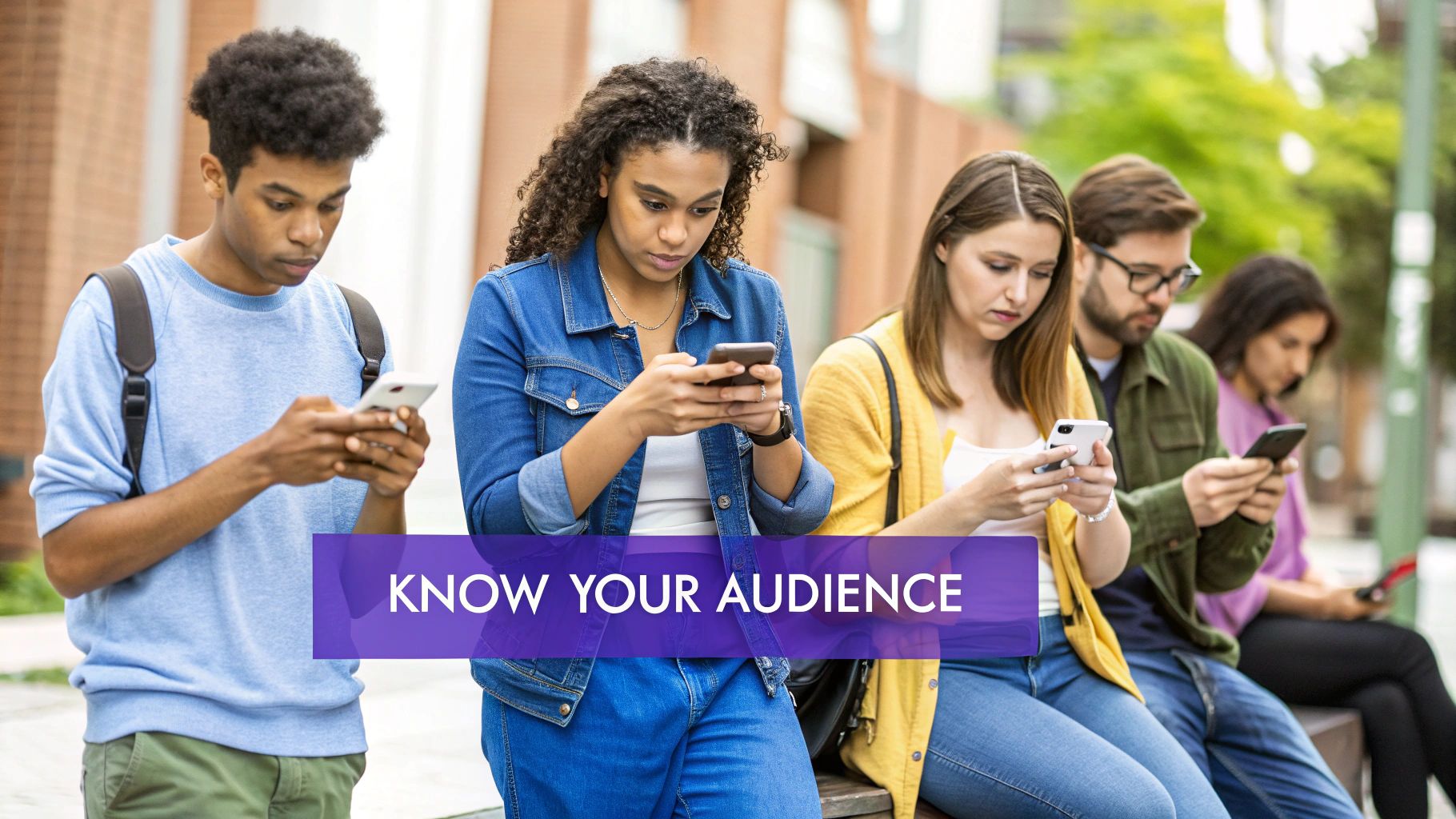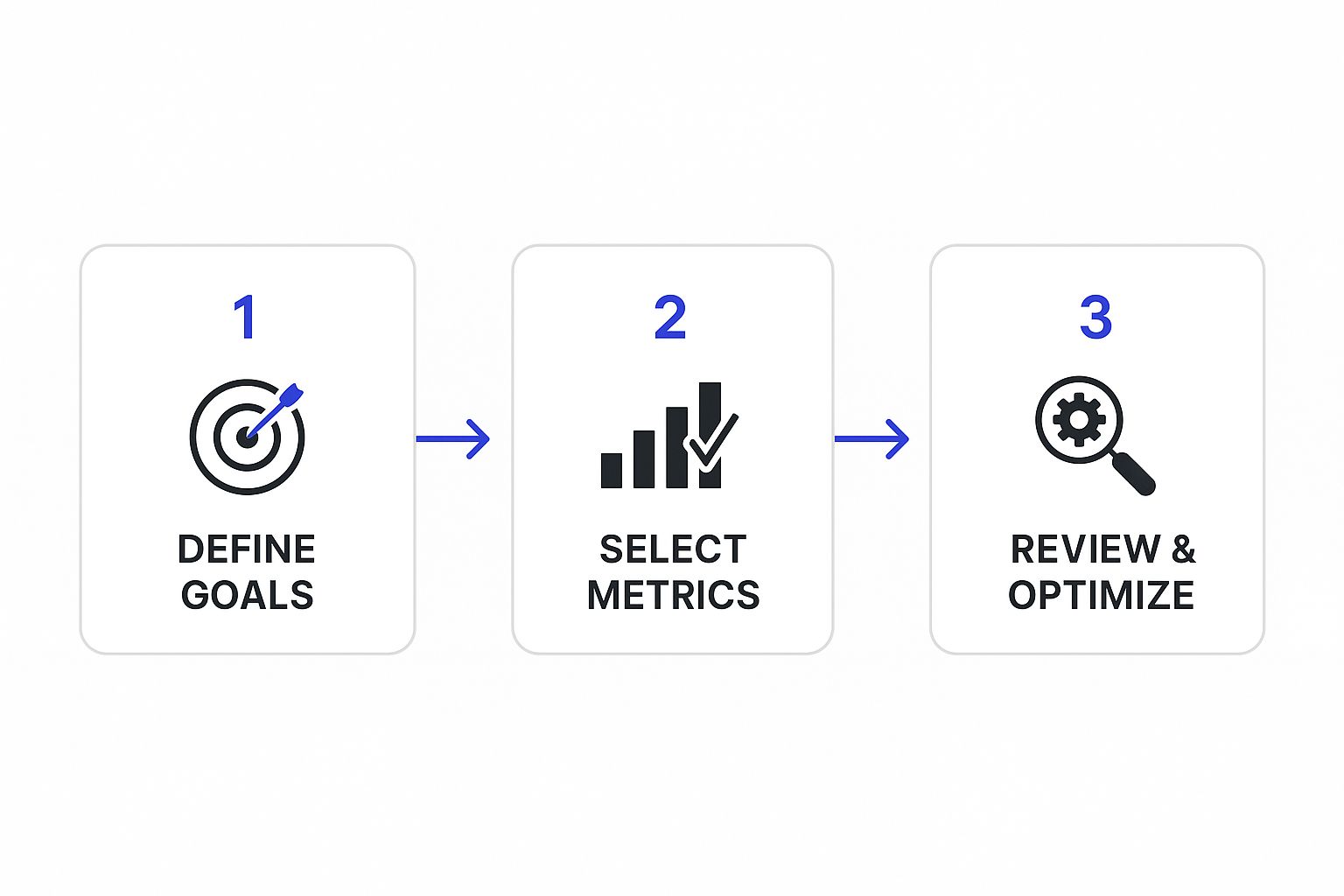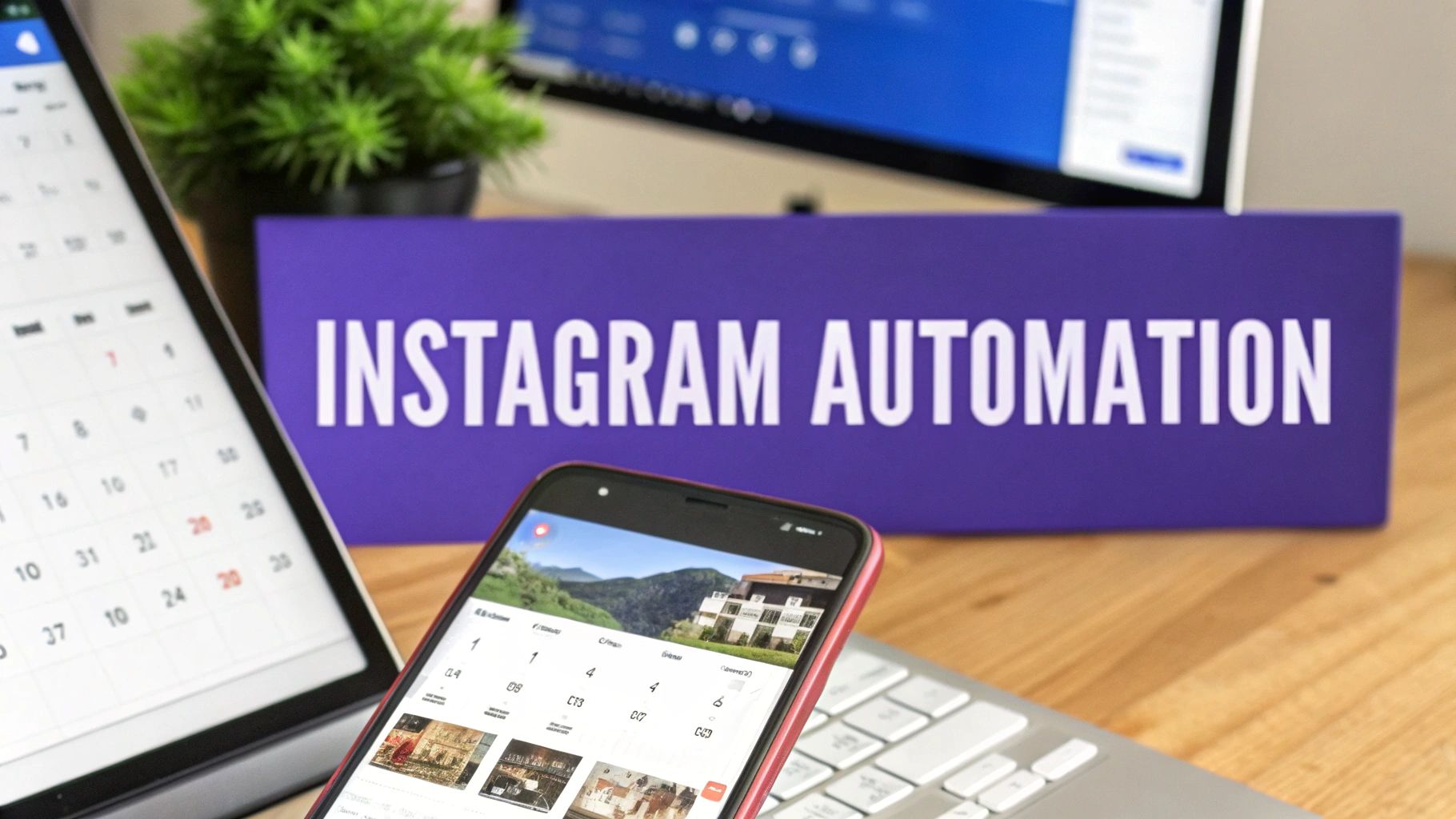Let's be real for a moment.Let's be real for a moment. Improving your social media engagement isn't about chasing vanity metrics or gaming the algorithm. It's about building a genuine community. The secret? A focused strategy that blends authentic content with consistent, meaningful interactions.
This simple shift changes everything. You stop broadcasting messages at people and start having real conversations with them.
Why Most Social Media Engagement Advice Fails

Ever feel like you’re shouting into a void? You spend hours crafting what you think is a killer post, you follow all the so-called "best practices," and... crickets. Maybe a few sympathy likes. It’s a frustratingly common story, and it happens because most of the standard advice out there misses the entire point. It focuses on tactics, not connection.
The digital world is unbelievably crowded. As of early 2025, there are around 5.31 billion social media users across the globe—that’s nearly 64.7% of the entire population. To put that in perspective, that number was just over two billion back in 2015. You can dig into the full research on social media user growth to see just how central these platforms have become.
This massive audience is a double-edged sword. It’s a huge opportunity, but it also means you’re fighting for every sliver of attention. Generic advice like "post more" or "use trending audio" is a fast track to burnout and content that feels totally disconnected from who you are.
Shifting From Tactics To True Connection
Here's the thing: real engagement isn't about tricking a system. It's about understanding people. Nobody logs onto Instagram or TikTok hoping to be sold to. They're there to connect with others, be entertained, or maybe learn something new. When your strategy serves these core human desires, engagement just... happens.
"Your content should be targeted to your current audience, as well as the audience you hope to gain. To do that, you need to engage with local businesses, current followers, and other brands in your niche via comments."
This means ditching the one-size-fits-all approach for good. A brilliant LinkedIn strategy will almost certainly bomb on TikTok. True, sustainable success is built around a few core pillars that work everywhere.
Core Pillars of Social Media Engagement
Before you can build a strategy that actually delivers, you need a solid foundation. Instead of getting distracted by fleeting trends, channeling your energy into these three fundamental areas will foster the genuine interaction and community you're looking for.
| Pillar | Key Action | Why It Works |
|---|---|---|
| Authenticity | Develop a consistent brand voice that reflects your true personality and values. | People connect with realness, not polished corporate perfection. It builds trust and makes your brand relatable. |
| Value | Create content that educates, entertains, or solves a problem for your audience. | Providing value makes your account a go-to resource, encouraging follows, saves, and shares. |
| Interaction | Actively participate in conversations, respond to comments, and engage with other accounts. | Engagement is a two-way street. Interacting shows you care and makes your audience feel seen and heard. |
Nail these three, and you'll be well on your way to building a thriving community that not only follows you but actively champions your brand.
Figure Out What Your Audience Actually Wants
Let's be real: throwing generic content at the wall and hoping something sticks is the fastest way to get scrolled past. If you want to boost your social media engagement, you have to stop guessing and start digging into what truly makes your audience tick.
Your current followers are a goldmine of information, and it's time to start panning for it. Dive straight into your platform analytics. Most social networks give you a surprisingly detailed look at your followers' age, gender, location, and—most importantly—their activity.
Look for the outliers. Which posts blew up? Was it a quick-tip video, a behind-the-scenes photo dump, or a heartfelt customer story? These aren't just vanity metrics; they're direct clues telling you what your audience craves.
For example, I once worked with a local coffee shop that noticed their simple videos on how to make latte art got 3x more saves and shares than polished photos of their storefront. That's a huge signal! It told them their audience didn't just want to see coffee; they wanted to learn a new skill.
Go Beyond Your Own Analytics
Looking at your own data is crucial, but it only tells half the story. You also need to understand the bigger conversation happening in your corner of the internet. This is where social listening becomes your secret weapon.
Think of it as eavesdropping (ethically, of course). You're monitoring mentions of your brand, your competitors, and the keywords that define your industry. It's how you find out what potential customers are saying when they think no brand is watching.
What you're listening for:
- Pain Points: What are people constantly complaining about that your product or service can fix?
- Competitor Love: What are people raving about from your competitors? Take notes.
- Unanswered Questions: What needs or questions keep popping up that nobody in your industry is addressing?
This entire process—setting goals, picking the right metrics, and tweaking your strategy—is a loop. It never really ends.

As this shows, understanding your audience isn't a "one-and-done" task. It’s a continuous cycle of learning, testing, and refining.
Build Personas That Actually Work
Once you have all this great intel, it's time to pull it together into audience personas. And I don't mean a flimsy "Female, 25-34, lives in the city." That’s not a persona; it's a demographic.
A truly effective persona feels like a real person. It should include their goals, biggest challenges, how they like to communicate, and which social media apps they open first thing in the morning. This detailed picture becomes your North Star for every single piece of content you create.
If you’re heavy on video, you absolutely have to get a handle on what keeps people watching. This means mastering video engagement metrics to see exactly where viewers drop off or re-watch.
By combining your platform analytics with sharp social listening and well-defined personas, you create a powerful framework. This is how you stop just posting at people and start creating content that feels personal, sparking the meaningful interactions that define real engagement.
Creating Content That People Want to Share

Alright, this is where your strategy gets real. We’re moving from ideas on a whiteboard to actual, tangible posts that show up in people’s feeds. Crafting content that gets shared isn't just about pretty pictures or clever captions; it’s about making posts that practically beg people to get involved.
The real goal? To create something so useful, funny, or relatable that your audience’s first instinct is to hit that share button. You want them to think, "Oh, my friend has to see this." This comes from a deep understanding of what makes people tick—and what makes them share.
Spark Conversations With Interactive Formats
Let’s be honest: passive scrolling is the engagement killer. Your job is to jolt people out of their scrolling stupor and give them something to do. This is where interactive formats become your secret weapon. They break down the digital wall and pull your followers directly into the conversation.
And I don't just mean asking a generic question in your caption. Go deeper and use the tools the platforms give you:
- Polls and Quizzes: These are pure gold. They're low-effort for your audience but give you instant feedback. Ask about their favorite product, test their industry knowledge, or even let them decide what you should post next.
- "Ask Me Anything" (AMA) Sessions: Whether on a live video or through your stories, AMAs build a powerful, personal connection. They show you're transparent, approachable, and confident enough to answer questions on the fly.
- "This or That" Carousels: A super simple and visual way to get people talking. Just create a carousel where each slide gives two options. It’s fun, drives comments, and gives you a peek into what your audience loves.
These formats work because they make your followers feel seen and heard without asking too much of them. To keep this momentum going, you need a solid plan. I’ve found that adopting effective social media content planning strategies is what separates sporadic success from consistent, predictable engagement.
Make Your Audience the Hero
One of the most powerful moves you can make is to turn the spotlight away from your brand and onto your community. User-generated content (UGC) is the perfect way to do this. It’s a brilliant strategy that not only celebrates your followers but also builds incredible social proof.
Encourage your audience to share photos or videos of them using your product. Give them a unique, branded hashtag to tie it all together. This does two things: it creates a massive library of authentic content for you to use, and it transforms your customers into passionate brand advocates.
When you feature a customer's post on your feed, you're doing more than just filling a slot on your content calendar. You're giving them a shout-out, validating their experience, and showing genuine appreciation. That small act fosters a ton of loyalty and inspires others to share, hoping for their own moment in the spotlight. If you need a hand with this, our guide on how to find trending hashtags can help you get way more eyes on your campaign.
Humanize Your Brand Voice
Let’s get one thing straight: nobody wants to talk to a logo. Polished, corporate jargon is a massive turn-off. The average person now spends around 2 hours and 21 minutes on social media every single day, scrolling through nearly seven different platforms a month. In a sea of endless content, a genuine human touch is what grabs attention.
Don't be afraid to show the real people behind your brand. Post some behind-the-scenes moments, talk openly about a challenge your team overcame, and let your unique personality come through. A little bit of vulnerability goes a long way. It builds trust and turns those passive scrollers into a real community that’s invested in your journey.
Choose and Master the Right Platforms
Trying to be everywhere at once on social media is a surefire way to burn out and get mediocre results. I've seen it happen time and time again. The secret to actually boosting your engagement isn't about planting a flag on every single platform; it's about making a genuine impact on the right ones.
When you spread your resources too thin, your content gets watered down and your interactions feel shallow. A focused approach is always better. It lets you dive deep into the unique culture of a platform and really understand what its users expect. A witty, meme-heavy post that goes viral on X (formerly Twitter) would absolutely tank on a professional network like LinkedIn. Mastering a platform means you're not just broadcasting on it—you're participating in its community the right way.
Align Your Brand with Platform Demographics
First things first: you need to play matchmaker between your target audience and the primary user base of each platform. It's just common sense. If your brand is all about connecting with Gen Z, you should be pouring your energy into visually-driven hubs like TikTok and Instagram. On the flip side, if you're a B2B company trying to reach executive-level decision-makers, LinkedIn is your undisputed champion.
Let's look at the hard data for a second. Facebook remains a giant, with over 3.065 billion monthly active users projected for 2025. Its biggest demographic slice is the 25-34 age bracket, making up 31.1% of its audience. For a lot of businesses, it’s also a key channel for customer service and direct sales—a whopping 39% of consumers have bought something through the platform. You can dig into more social media demographics to make sure your efforts are landing where they should.
Your goal isn't just to find where your audience hangs out, but where they are most receptive to your message. Figure out where your ideal customer is actively looking for information, entertainment, and community related to what you do.
Picking the right platform is the first critical step. But real engagement? That comes from adapting your content to truly shine in that specific environment.
Stop Cross-Posting and Start Adapting
I can't stress this enough: simply copying and pasting the exact same post across all your channels is a massive mistake. Every platform has its own unwritten rules, its own vibe, and its own preferred content formats. To get real traction, you have to tailor your core message for each one.
Here’s a quick example of how that might work for a new product launch:
- Instagram: You'd create a visually stunning Reel that shows the product in action, set to trending audio.
- LinkedIn: The same launch would be better as a thoughtful article. You could detail the problem your product solves and discuss its broader impact on the industry.
- Facebook: Here, you could host a live Q&A session inside a dedicated brand group, answering customer questions in real-time and building community.
This tailored approach shows you respect the user's experience on each platform and understand why they're there. You're meeting them on their terms.
Short-form video is an especially powerful tool for this, but just hitting record isn't enough. For a much deeper look, check out our guide to master video marketing for social media to learn how to adapt your clips for maximum impact.
When you focus your energy and adapt your content, your social media stops being a chore and starts becoming a high-impact engagement engine.
Building a Community, Not Just a Following

If you think your job is done once you hit "publish," it's time for a mindset shift. That's actually just the beginning. Real social media engagement is a two-way street, and the real work starts the moment your content goes live.
This is where you stop chasing followers and start building a loyal community. It’s a critical distinction. Your goal is to show your audience that there's a real, caring person behind the brand who actually values what they have to say. Every single comment, message, and mention is an opportunity to forge a stronger bond.
Respond Promptly and Personally
A quick response can make all the difference. When someone takes the time to leave a comment, they're opening a door to conversation. Your job is to walk through it as quickly and genuinely as you can.
Try to reply to comments and DMs within a few hours, or at the very least, within the same business day. This simple act shows you're paying attention and that their interaction truly matters. More importantly, you have to ditch the generic, copy-paste replies. Personalize your responses—use their name and reference something specific from their comment.
For instance, if someone comments, "Wow, great tip! I'm going to try this," don't just say "Thanks!" A much better reply would be, "So glad you found it helpful, Sarah! Let me know how it works out for you." It’s a tiny tweak that creates a much more powerful connection.
Handle All Feedback With Grace
Let's be real: not every interaction will be a glowing review, and that's completely okay. Honestly, how you handle negative feedback says more about your brand than how you handle praise. Seeing a negative comment can sting, but your first instinct should always be to help, not get defensive.
Here’s a simple game plan:
- Acknowledge and Validate: Start by acknowledging their concern. A simple, "I'm sorry to hear you had this experience," immediately shows empathy.
- Move to a Private Channel: For more complex issues, offer to continue the conversation in DMs or over email. This protects their privacy and takes a potentially heated exchange out of the public spotlight.
- Learn from It: Remember, negative feedback is basically free market research. Use it to find blind spots in your products, services, or content.
Turning a negative experience into a positive one is one of the most powerful ways to build brand loyalty. A customer who feels heard and helped is far more likely to stick around than one who is ignored.
Be Proactive, Not Just Reactive
Simply waiting for comments to roll in isn't enough to truly improve social media engagement. You need to get out there and actively create conversations. This means becoming a real participant in your niche, not just on your own profile.
Spend a little time each day engaging with other accounts. Jump into conversations on relevant hashtags, leave thoughtful comments on posts from industry leaders, and share content from your own community members. Highlighting user-generated content (UGC) is especially powerful—it makes your audience feel seen and appreciated while giving you authentic content to share.
This proactive, community-first approach is what ultimately turns followers into a tribe of genuine advocates. If you're wondering where these conversations are happening, check out our guide on the top 10 social media platforms dominating 2025 to find the right spaces for your brand.
Answering Your Biggest Social Media Engagement Questions
Even when you've nailed down your audience and are creating killer content, a few persistent questions can still pop up. It happens to everyone. You're putting in the effort, but you can't shake that feeling that you could be doing more.
Let's cut through the noise and tackle some of the most common questions I hear about social media engagement.
"How Often Should I Even Be Posting?"
This is the big one. There's a fine line between staying top-of-mind and just plain annoying your followers. You don't want to vanish from their feeds, but you also don't want to spam them into hitting "unfollow."
Forget the idea of a single magic number. The real secret is consistency over quantity.
For a visual platform like Instagram, aiming for 3-5 high-quality posts per week is a fantastic goal. It's far more effective than posting something low-effort every single day just for the sake of it. On the other hand, for a fast-paced feed like X (formerly Twitter), you might find that 2-3 posts a day is the sweet spot.
The trick is to find a rhythm you can actually stick to without letting your quality dip.
"What Are the Best Times to Post?"
This is another classic, but the answer is simpler than you think: post when your audience is actually online and scrolling. All that generic advice about posting at 9 AM on a Tuesday? It's pretty much useless because every single audience is unique.
Your best friend here is your own data.
Go dive into your Instagram Insights or Facebook Page analytics. Look for the "Most Active Times" report. This is gold—it shows you, hour by hour, exactly when your followers are most likely to be active on the platform.
Start by testing posts during these peak hours. A pro tip is to post just before a major spike in activity. This lets you catch the engagement wave as it starts to build. Track your results for a couple of weeks, look for the patterns, and then build your content schedule around that hard data.
This isn't about guesswork. It's about making sure your content goes live at the most impactful moment for your community, not just the most convenient time for you.
"Am I Measuring the Right Things?"
So, how do you know if all this effort is paying off? Likes are a nice little ego boost, but they barely scratch the surface. To really understand if you’re able to improve social media engagement, you have to look at the metrics that signal a deeper connection.
Focus your attention on these key indicators:
- Shares: This is the ultimate compliment. It means your content was so good that someone wanted to broadcast it to their own network.
- Saves: When someone saves your post, they're bookmarking it as a valuable resource to come back to later. This is a huge win, especially for educational or inspiring content.
- Comments: I'm not talking about a single fire emoji. I mean real, thoughtful comments that show you've sparked a genuine conversation.
Content that teaches, inspires, or gives a behind-the-scenes peek—like tutorials, checklists, powerful quotes, or a transparent look at your business—is what earns those coveted shares and saves. For a wider view on this, you can find some excellent tips on how to increase customer engagement across every part of your brand.
When you start tracking these deeper metrics, you get a much clearer, more honest picture of your community's health and the true impact of your strategy.
Ready to stop guessing and start seeing real results? PostSyncer gives you all the tools you need in one place, from AI-powered scheduling that finds your perfect post times to in-depth analytics that track the metrics that matter. Streamline your entire workflow and build a thriving community with our 7-day free trial. Learn more at https://postsyncer.com.















